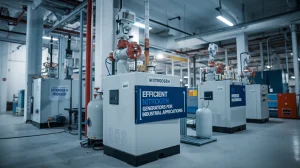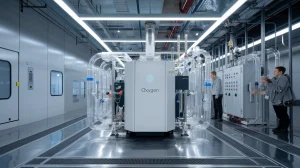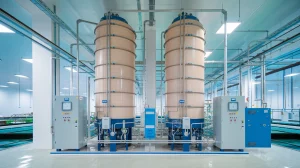Oxygen generators are vital devices that produce high purity oxygen for various applications, ranging from medical therapy to industrial processes. They operate by extracting oxygen from the surrounding air, making it readily available for use. Whether for individuals suffering from respiratory conditions or for industries requiring oxygen gas, these generators play a crucial role in ensuring a consistent supply of oxygen.
History of Oxygen Generation
The development of oxygen generation technology has evolved significantly over the years. Initially, oxygen was stored and transported in heavy oxygen tanks. With advancements in technology, the focus shifted towards on-site oxygen generation.
This shift led to the creation of devices like oxygen concentrators and portable oxygen concentrators, which provide a more convenient and efficient means of supplying oxygen.
Basic Principles of Oxygen Generation
Understanding how an oxygen generator works involves grasping the basic principles of air separation. The process typically starts with compressed air, which is then filtered to remove impurities. The purified air is directed through a molecular sieve that adsorbs nitrogen molecules, allowing oxygen molecules to pass through.
This process results in the production of high purity oxygen, which can be used for various applications.
Types of Oxygen Generators
An Oxygen generator comes in various types, each employing different technologies to extract oxygen. The main types include Pressure Swing Adsorption (PSA) oxygen concentrators, membrane oxygen generators, and chemical oxygen concentrators.
Each type has its unique method of separating oxygen from air, catering to different needs and applications.
There is another form of oxygen generators, the portable oxygen concentrator, which is designed for mobility and ease of use. This compact device provides continuous oxygen therapy, ensuring that individuals can maintain their oxygen level while traveling, working, or performing daily activities without being confined to a stationary oxygen source.
Components of an Oxygen Generator
Key components of an oxygen generator include the air compressor, molecular sieve, oxygen tank, and filters. Air compressors are responsible for compressing ambient air, while the molecular sieve separates nitrogen from oxygen. The resulting oxygen is stored in an oxygen tank for use. Filters ensure that the air entering the system is free from contaminants, enhancing the purity of the produced oxygen.
Pressure Swing Adsorption (PSA) Technology
A PSA oxygen generator is widely used due to their efficiency in producing high purity oxygen. This technology relies on adsorbent materials that selectively adsorb nitrogen molecules from compressed air. The adsorbed nitrogen is then released during the pressure swing cycle, leaving behind purified oxygen. PSA generators are commonly used in medical and industrial applications.
Membrane Oxygen Generators
A membrane oxygen generator uses a different approach to separate oxygen from air. They employ selective membranes that allow oxygen molecules to pass through while blocking nitrogen molecules. This method is effective for producing oxygen for various applications, including medical therapy and industrial procedures.
Chemical Oxygen Generators
A chemical oxygen generator produces oxygen through chemical reactions. These generators are often used in emergency situations where a quick and reliable source of oxygen is needed. The chemical reactions release oxygen gas, which can be used immediately. This type of generator is commonly found in safety equipment and emergency kits.
Industrial Applications of an Oxygen Generator
In industrial settings, an oxygen generator is used to enhance combustion processes, support wastewater treatment, and facilitate metal cutting and welding. The availability of on-site oxygen generation reduces dependency on external gas supply and ensures a steady flow of oxygen, optimizing various industrial operations.
Medical Applications of an Oxygen Generator
PSA Oxygen generators are crucial in medical applications, particularly for patients with chronic obstructive pulmonary disease (COPD) and other respiratory conditions. These devices provide supplemental oxygen therapy, improving oxygen levels in the blood and alleviating symptoms of difficulty breathing. Both stationary and portable oxygen concentrators are used to meet the needs of patients at home and on the go.
Environmental Applications
In environmental management, an oxygen generator plays a role in processes such as bioremediation and aquaculture. By providing a continuous supply of oxygen, these generators support the growth of aerobic organisms and enhance the breakdown of pollutants, contributing to environmental sustainability.
Benefits of On-site Oxygen Generation
On-site oxygen generation offers several benefits, including reduced costs, improved efficiency, and enhanced safety. By generating oxygen on demand, facilities can eliminate the need for frequent deliveries of oxygen tanks, reduce storage requirements, and ensure a consistent supply of oxygen tailored to their specific needs.
Learn more about energy consumption of oxygen genereators.
Safety and Maintenance
Ensuring the safety and reliability of oxygen concentrators involves regular maintenance and adherence to safety protocols. Proper maintenance includes checking filters, monitoring oxygen output, and ensuring the system is free from leaks. Safety measures, such as avoiding the use of flammable materials near oxygen outlets, are crucial to prevent accidents.
Advancements in Oxygen Generation Technology
Recent advancements in oxygen generation technology have led to more efficient and compact devices. Innovations such as improved molecular sieves, energy-efficient compressors, and advanced control systems have enhanced the performance of both home oxygen concentrators and industrial oxygen generators.
These advancements ensure higher oxygen purity, lower energy consumption, and greater user convenience.
Future Trends in Oxygen Generation
The future of oxygen generation technology looks promising, with ongoing research and development aimed at further improving efficiency and accessibility. Emerging trends include the integration of smart technologies for real-time monitoring and control, development of more portable and lightweight devices, and exploration of new materials for better nitrogen adsorption.
These trends are expected to expand the applications of oxygen concentrators, making high purity oxygen more readily available for various needs.
In conclusion, oxygen generators and concentrators play a vital role in providing a reliable supply of pure oxygen for medical, industrial, and environmental applications. Understanding how these devices work, their components, and their benefits helps in appreciating their importance in modern society. As technology continues to advance, we can expect even more efficient and versatile oxygen generation solutions in the future.
Contact Us Today
After addressing the question “How does an oxygen generator work?” we invite you to get in touch with Berg-Gasetech for further assistance and information.
At Berg-Gasetech, we are dedicated to providing top-notch oxygen generation solutions tailored to your specific needs. Whether you have questions about our products, require technical support, or need assistance with your order, our dedicated team is here to help. You can reach us through our website, email, or phone.
Our knowledgeable staff is ready to offer expert advice and ensure you receive the best service possible. We value your inquiries and are committed to delivering exceptional support.
Contact us today and experience the Berg-Gasetech difference! We look forward to serving you and meeting all your oxygen generation needs. Our team is eager to assist with any technical or logistical questions you may have, ensuring a seamless experience.




